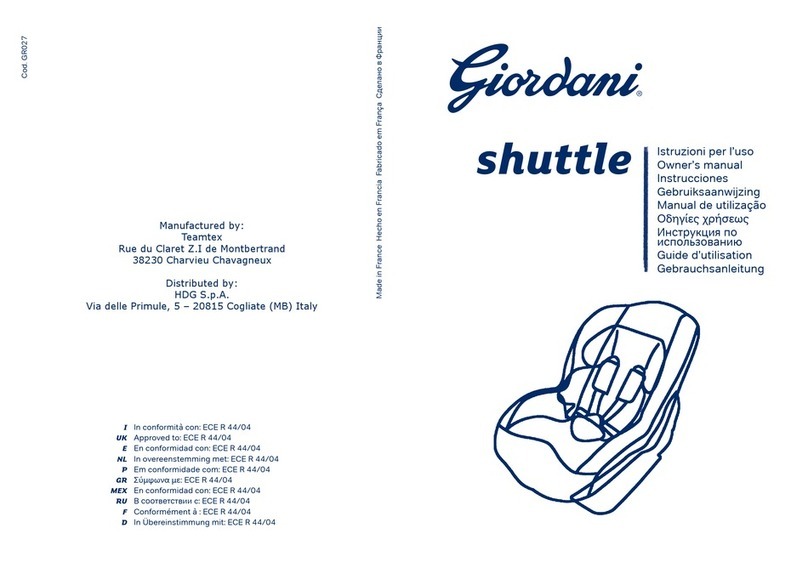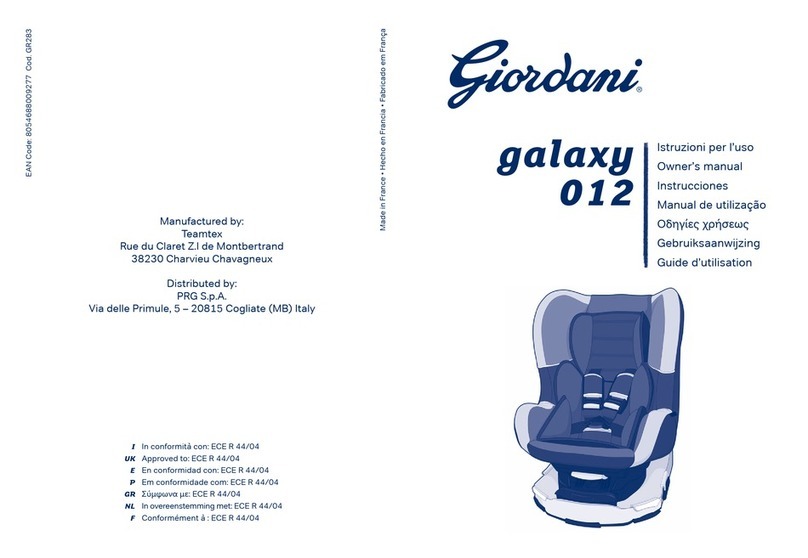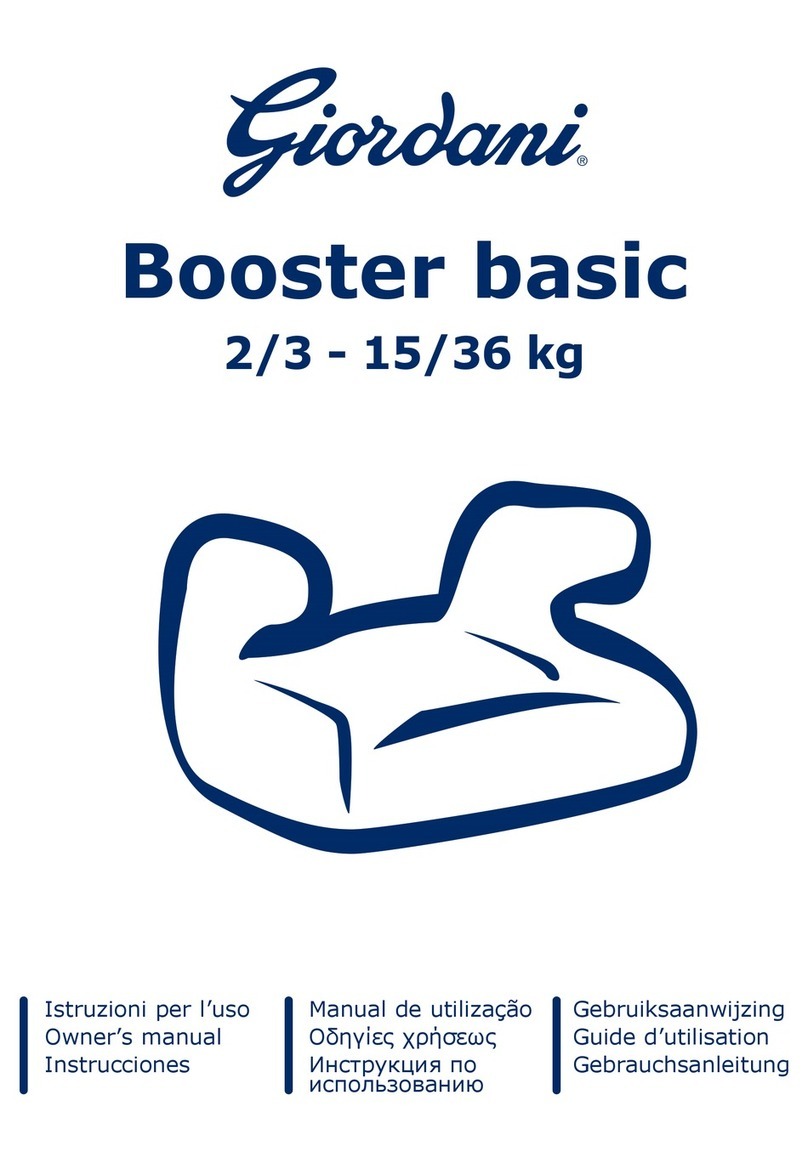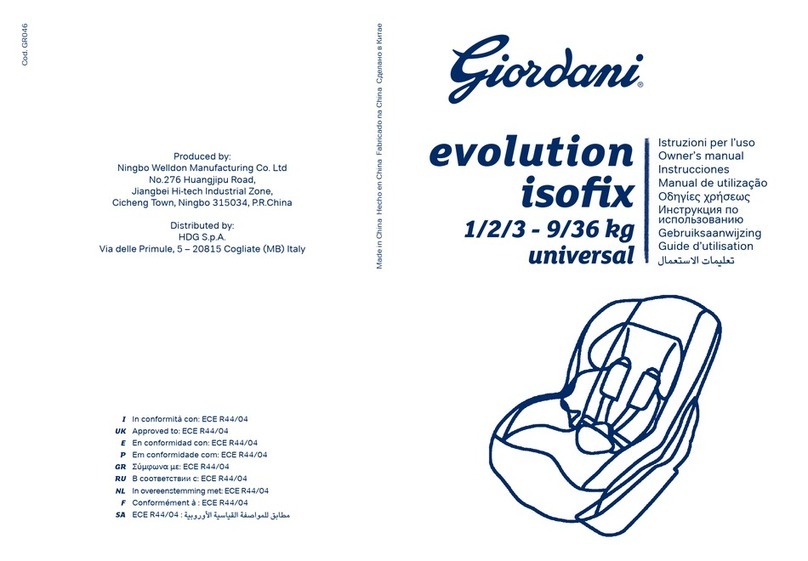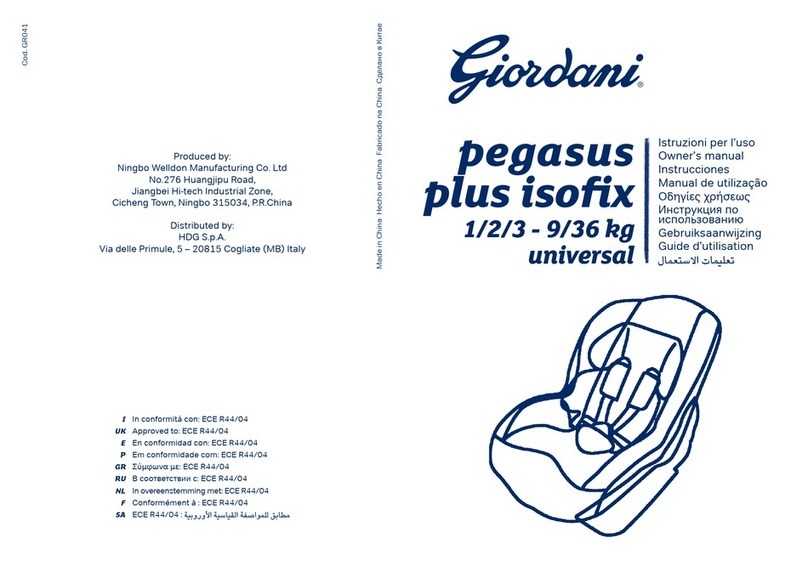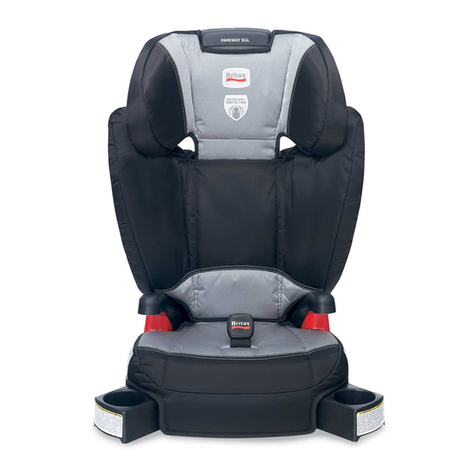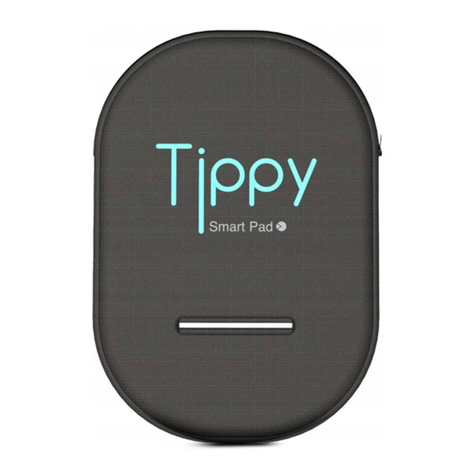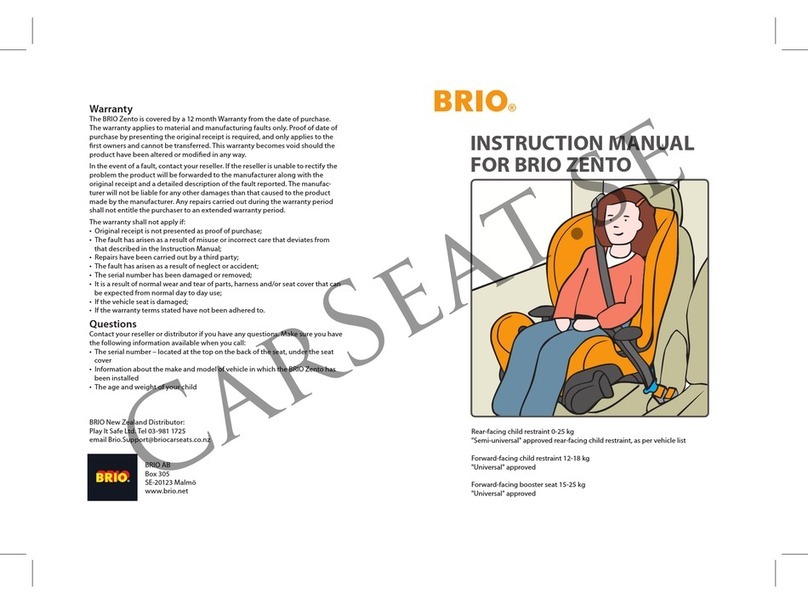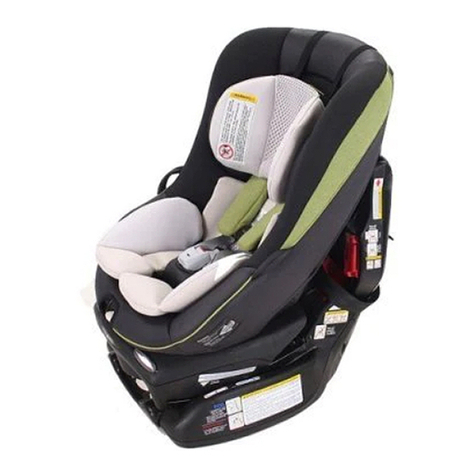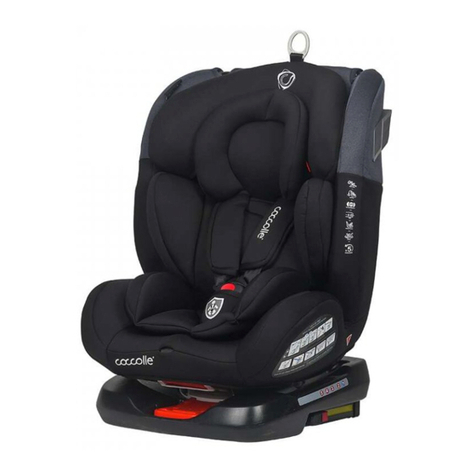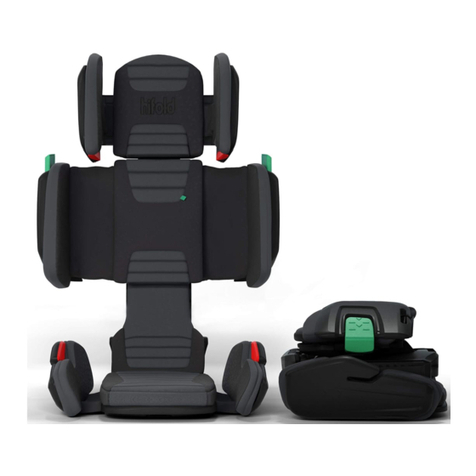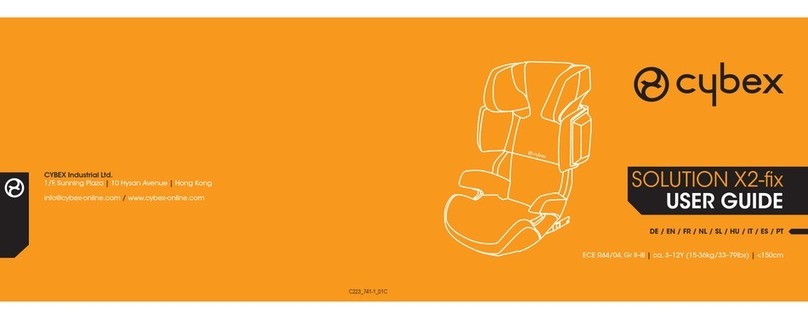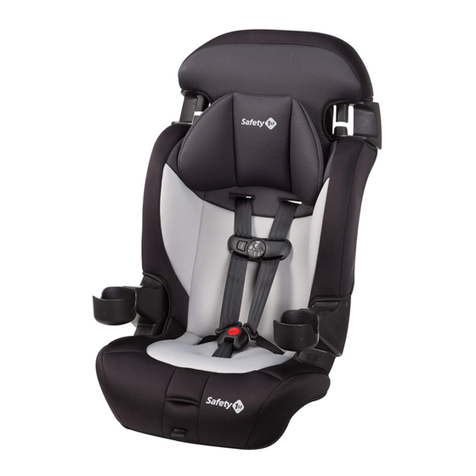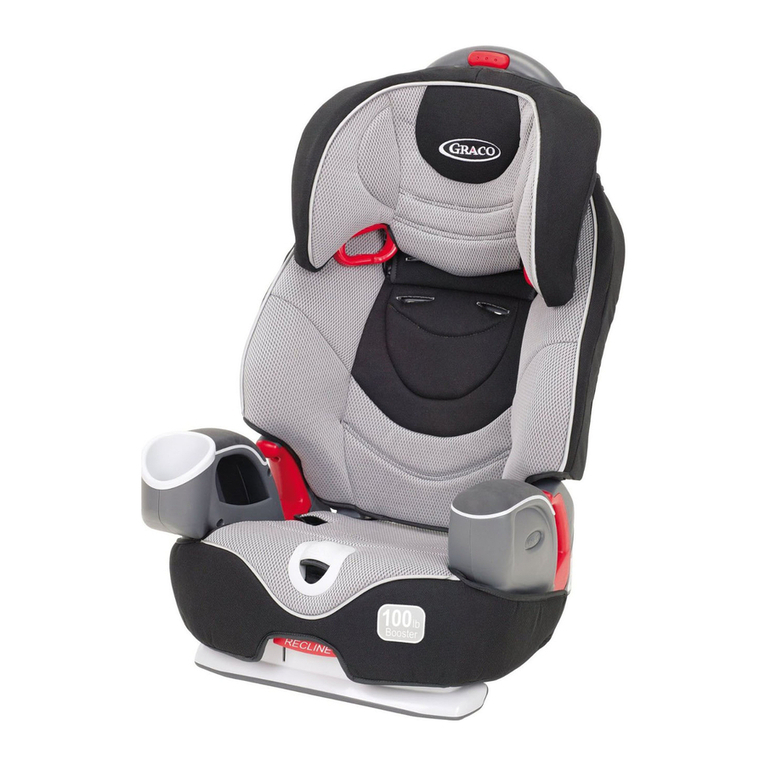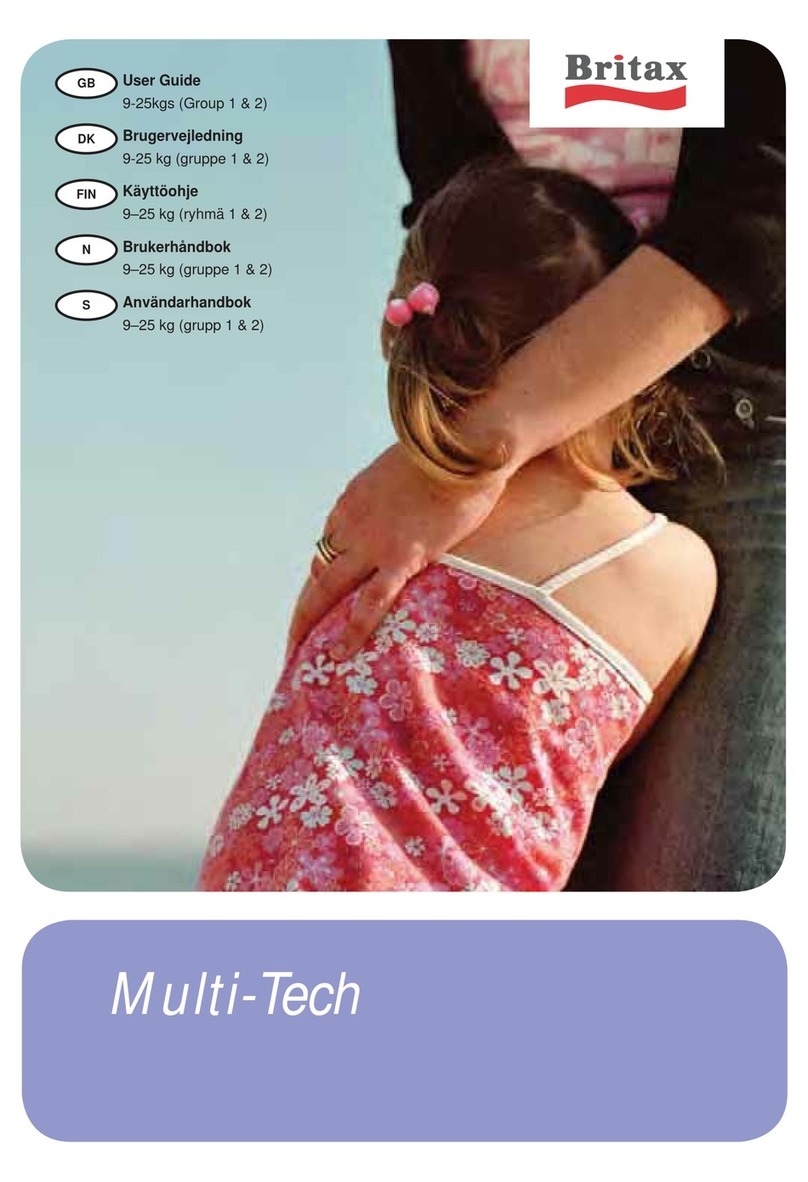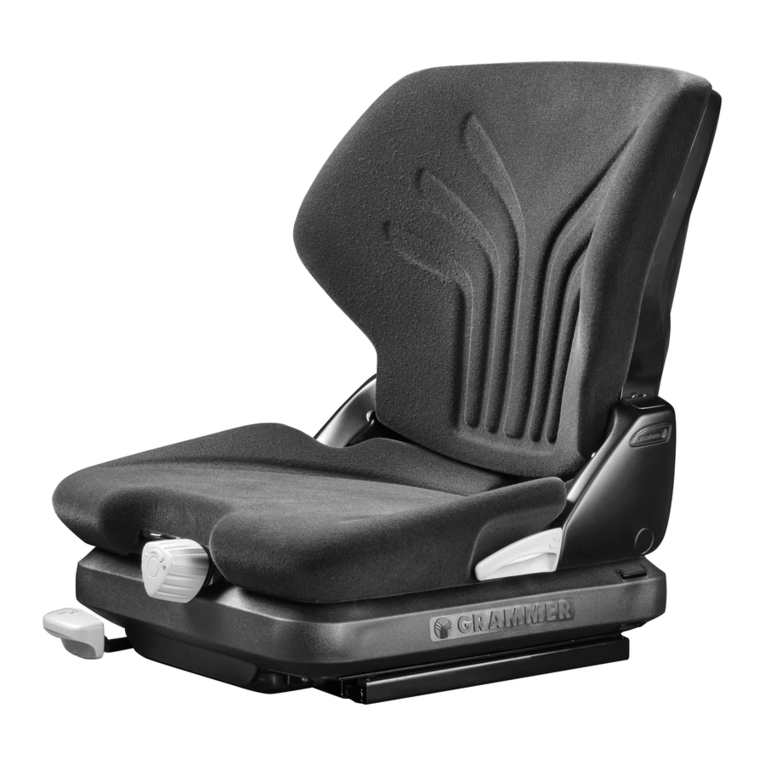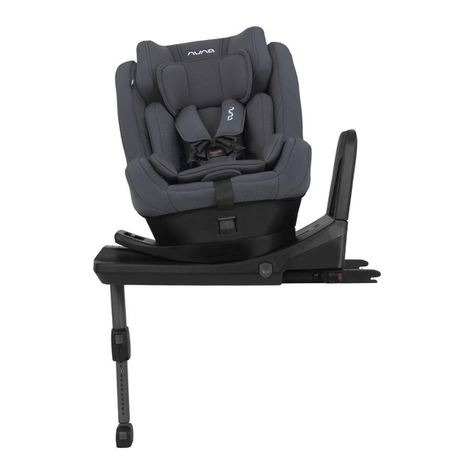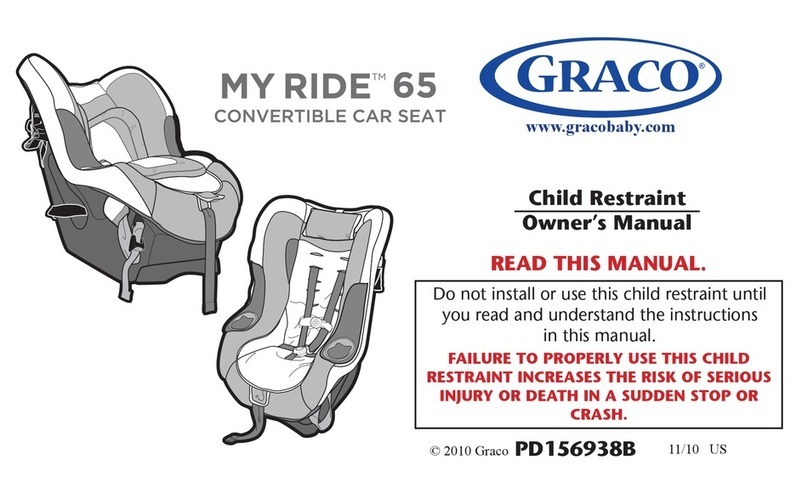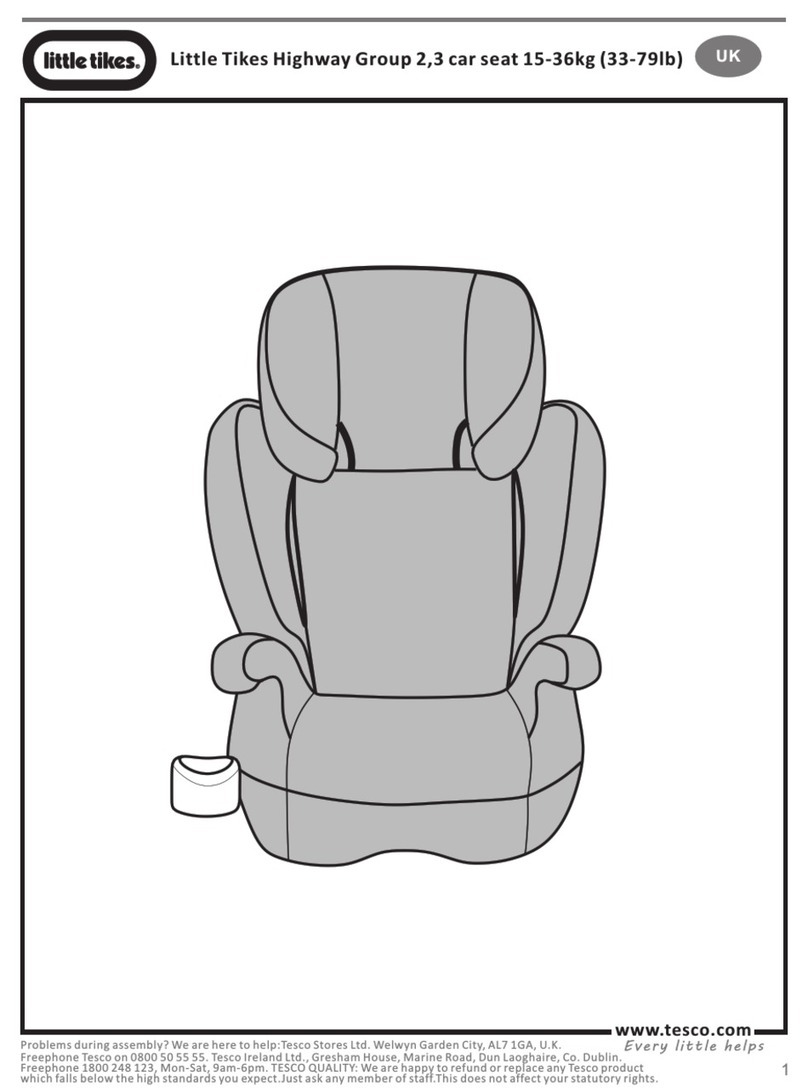
14
delle bretelle e inserirli nella bbia in modo
da raggruppare i componenti delle bretelle
e della cinghia inguinale. Ciò consentirà di
conservare più facilmente questi elementi
per esigenze future. Ripetere le operazioni
(1) e (1/a) per le estremità superiori di en-
trambe le bretelle. Rimuovere l’estremità
inferiore di una bretella facendo ruotare il
dispositivo di arresto metallico posto sotto
la seduta del seggiolino, quindi far passare
l’estremità della bretella attraverso le
fessure della seduta e del rivestimento
(4/a). Ripetere l’operazione con l’altra
bretella. Rimuovere la cinghia inguinale
facendo ruotare il dispositivo di arresto
metallico e facendolo passare attraverso
le fessure della seduta e del rivestimento
(4/b).
5. Questo seggiolino per auto è dotato di
un poggiatesta regolabile, concepito per
accompagnare il bambino durante la
crescita, in modo da fornire la massima
protezione laterale. Alzare al massimo
il poggiatesta regolabile. Posizionare
il seggiolino contro il sedile posteriore
dell’auto e far passare la parte diagonale
della cintura attraverso la guida del pog-
giatesta (5/a) (5/b). Collocare il bambino
nel seggiolino vericando che la schiena
sia ben a contatto con lo schienale del
seggiolino. Tirare e allacciare la cintura
di sicurezza dell’auto. Far passare la
parte diagonale della cintura sotto il
bracciolo opposto alla guida della cintura
utilizzata; la parte addominale della
cintura di sicurezza dell’auto va fatta
passare sotto entrambi i braccioli (5/c).
Abbassare il poggiatesta e regolarlo in
base alle misure del bambino (5/d).
Deve essere posizionato in modo da
avvolgere bene la testa del bambino per
la massima protezione laterale; la cintura
diagonale deve essere posizionata sulla
spalla e non deve venire a contatto con
il collo del bambino (5/e) (5/f). Tendere
la cintura di sicurezza dell’auto.
Vericare che la cintura sia tesa cor-
rettamente, che non sia attorcigliata e
che non venga a contatto con il collo del
bambino.
6. Per togliere il bambino dal seggiolino,
slacciare la cintura di sicurezza dell’auto
sul lato del seggiolino. La cintura resterà
sospesa all’apposita guida del poggiate-
sta.
ATTENZIONE: ssare sempre il seggio-
lino con la cintura di sicurezza dell’auto,
anche quando il bambino non si trova al
suo interno. In caso di urti, un seggiolino
non ssato può trasformarsi in un vero
e proprio proiettile.
CONFIGURAZIONE ORIGINALE
DEL SEGGIOLINO
7. Per ripristinare la congurazione con
bretelle, attenersi alle istruzioni seguenti.
Ricollocare la cinghia inguinale vericando
che il dispositivo di arresto metallico
sia posizionato correttamente sotto la
seduta. Ricollocare l’estremità inferiore
di una bretella vericando che il dispo-
sitivo di arresto metallico sia posiziona-
to correttamente sotto la seduta (7/a).
Ripetere l’operazione con l’altra bretella.
Ricollocare l’estremità superiore di una
bretella (7/b). Vericare che il disposi-
tivo di arresto metallico sia posizionato
correttamente dietro lo schienale (7/c).
Ripetere l’operazione con l’altra bretella.
Vericare che le estremità superiori e
inferiori delle bretelle non siano attorci-
gliate.
SISTEMAZIONE DELLE ISTRUZIONI
8. Conservare queste istruzioni sistemando-
le, a seconda del modello, nell’apposita
tasca oppure fra la scocca e la fodera
della seduta.
PULIZIA E MANUTENZIONE
Tutte le parti in tessuto sono sfoderabili. In
caso di macchie leggere, pulire con una spugna
15
inumidita con acqua saponata oppure lavare
a mano a 30° in acqua saponata. Non utiliz-
zare candeggina, non stirare, non lavare in
lavatrice, non asciugare in asciugabiancheria.
COMPOSIZIONI
Struttura: 100% Polipropilene
Rivestimento: 100% Poliestere
DIMENSIONI
L: 45 cm;
H: 49 cm;
P: 70 cm.
AVVERTENZE
•Installare il seggiolino gruppo 1-2-3 esclu-
sivamente su un sedile orientato in avanti
e dotato di una cintura di sicurezza a 3
punti.
•Gli elementi rigidi e i pezzi in materiale
plastico del dispositivo di ritenuta per
bambini devono essere posizionati e in-
stallati in modo tale che, nelle condizioni
di normale utilizzo, non possano bloccarsi
sotto un sedile mobile o nella porta del
veicolo.
•Mantenere tese tutte le cinghie che ser-
vono a ssare il dispositivo di ritenuta al
veicolo e regolare le bretelle che servono
a trattenere il bambino. Inoltre le cinghie
non devono essere attorcigliate.
•Accertarsi che le cinghie sub-addominali
siano il più in basso possibile, per man-
tenere una posizione ottimale del bacino.
•Sostituire il dispositivo quando sottoposto
a sforzi violenti in caso di incidente.
• È pericoloso modicare o completare il
dispositivo con elementi aggiuntivi di
qualsiasi tipo senza il consenso da parte
dell’autorità competente o non seguire
scrupolosamente le istruzioni riguardanti
l’installazione fornite dal produttore del
dispositivo di ritenuta per bambini.
•Tenere il seggiolino al riparo dai raggi
solari per evitare che il bambino possa
ustionarsi.
•Non lasciare il bambino senza sorveglianza
in un dispositivo di ritenuta per bambini.
• Vericare che i bagagli o altri oggetti
potenzialmente in grado di procurare
contusioni o ferite all’occupante del seg-
giolino in caso di urto siano solidamente
ancorati.
•Non utilizzare il dispositivo di ritenuta per
bambini senza la fodera.
•Non sostituire la fodera con una fodera
diversa da quella consigliata dal produt-
tore, in quanto ha un impatto diretto sul
funzionamento del dispositivo di ritenuta.
•In caso di dubbio riguardante l’installa-
zione e il corretto utilizzo del seggiolino,
contattare il produttore del dispositivo di
ritenuta per bambini.
•Installare il sistema di ritenuta per bambini
sui sedili classicati nella categoria «uni-
versale» nel manuale d’uso del veicolo.
•Non utilizzare punti di contatto di sostegno
diversi da quelli descritti nelle istruzioni
e contrassegnati sul sistema di ritenuta.
•Privilegiare sempre un’installazione sui
sedili posteriori anche quando il codice
della strada autorizza un’installazione sul
sedile anteriore.
• Vericare sempre che la cintura del veicolo
sia allacciata.
• Vericare sempre che non vi siano residui
alimentari o altro materiale nella bbia
dell’imbracatura o nel regolatore centrale.
•D’inverno, fare attenzione a non posizio-
nare il bambino nel seggiolino con abiti
troppo voluminosi.
•Questo seggiolino per auto è un dispositivo
di ritenuta «universale» per bambini.
Omologato in ottemperanza al regola-
mento N°44/04, è adatto per l’utilizzo
all’interno dei veicoli ed è compatibile
con la maggior parte (salvo eccezioni)
dei sedili delle auto.
•Si garantisce un compatibilità totale se il

